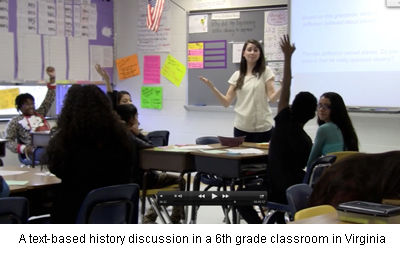Designing Opportunities for Text-Based Historical Discussions (Abby Reisman)

What does it take to transform the history classroom into a place marked by student exploration and discussion about the past?
For over a decade, I have worked with colleagues at the Stanford History Education Group to generate a set of concrete pedagogical and curricular tools that translate the lofty rhetoric of inquiry instruction into actual classroom practice. Most of these tools now appear in the Reading Like a Historian curriculum, a series of document-based lessons centered on legitimate, historical questions.
All of the Reading Like a Historian Document-Based Lessons share certain features that open history up to interpretation. They all include historical sources that have been modified for struggling readers, as well as multiple opportunities for students to engage in the skills of disciplinary historical reading: sourcing, contextualization, close reading, and corroboration. Each lesson is designed around a central historical question that points students to the documentary record. Results from a six-month intervention study in San Francisco high schools found that students in Reading Like a Historian classrooms outperformed their counterparts in reading comprehension, historical thinking, factual recall, and general reasoning.
The Document-Based Lessons also have a predictable sequence of classroom activities. Students begin by reviewing background information relevant to the inquiry, and then spend the bulk of the class reading and interpreting the documents. The lessons are intentionally designed to culminate with a whole-class discussion, where students offer and reconcile competing responses to the central historical question.
Yet, in my analysis of videotaped instruction, I was struck by the near absence of whole-class discussion, despite the explicit call for discussion in the curricular materials. In a recent article, “Entering the Historical Problem Space: Whole-class Text-based Discussion in History Class” (Teachers College Record 117, no. 2 [2015]: 1-44), I discuss the difficulties that teachers encountered in attempting to facilitate text-based discussion about the past, and I identify facilitation moves that might promote student argumentation and reasoning with texts. I found that in productive discussions, the teacher raised specific questions about the text, revoiced students’ comments to make explicit the structure of the argument, and stabilized the historical content to ground the discussion in accurate claims about the past.
 This past year, I ran a study that explored how best to coach teachers in facilitating text-based whole-class discussion in history. I worked with four middle-school teachers over the course of the school year, observing their instruction, and offering targeted feedback on discussion facilitation. Although I am only in the earliest stages of data analysis, two important themes seem to be emerging: first, it is nearly impossible to give substantive feedback on discussion facilitation without attending to the curricular resources themselves and the historical understanding that they aim to elicit; second, teachers who view discussion as emerging spontaneously from students—as they, for example, make personal connections to the topic at hand—are less likely to perceive their own agency as facilitators who design opportunities for discussion. In other words, it appears that supporting teacher facilitation of text-based discussion is not as simple as sharing a list of discursive moves or providing access to curricular materials that scaffold historical interpretation. It appears that teachers must also see themselves as designers of opportunities for discussion and student interaction.
This past year, I ran a study that explored how best to coach teachers in facilitating text-based whole-class discussion in history. I worked with four middle-school teachers over the course of the school year, observing their instruction, and offering targeted feedback on discussion facilitation. Although I am only in the earliest stages of data analysis, two important themes seem to be emerging: first, it is nearly impossible to give substantive feedback on discussion facilitation without attending to the curricular resources themselves and the historical understanding that they aim to elicit; second, teachers who view discussion as emerging spontaneously from students—as they, for example, make personal connections to the topic at hand—are less likely to perceive their own agency as facilitators who design opportunities for discussion. In other words, it appears that supporting teacher facilitation of text-based discussion is not as simple as sharing a list of discursive moves or providing access to curricular materials that scaffold historical interpretation. It appears that teachers must also see themselves as designers of opportunities for discussion and student interaction.

